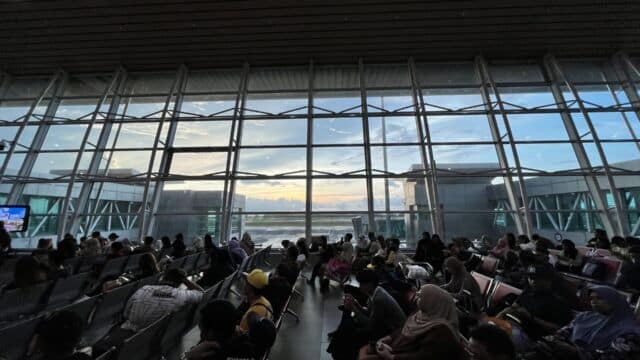Above a Drowned World, Existence is Resistance
Photo: Bethany Luhong Balan
Bayoh Lodge, Kapit, Sarawak | 1,837 words
The sign says Sungai Asap is 90 kilometers away. I sit up straighter in the backseat of my father’s old Hilux truck—or I try to, at least. The bumpy road jostles me around and I keep bumping shoulders with my sister. I take my phone out, checking the time. I do the calculations in my head. If my uncle keeps driving this fast, we’ll get there in a little over an hour.
My parents, my sister, and I are visiting my father’s homestay lodge that he built on the Bakun Dam reservoir. He wants us to check out the progress he’s made. I’m excited and a little bit nervous. My father goes back regularly but I haven’t been back to kampung in a while. Life and work and the sheer distance we have to travel makes it easier to stay behind in Kuching. But the journey is considerably shorter than it was when I was a kid. We don’t have to drive almost twenty hours on untarred roads, or take ferries or express boats anymore.
Now, it’s merely a
-fifty-minute flight from Kuching to Bintulu,
– a three-hour drive from the Bintulu airport to our longhouse, Uma Belor (to pick up supplies and any miscellaneous relatives who want to tag along)
-then a forty-five-minute drive to the Bakun Dam jetty,
-and finally a twenty-minute boat ride to the Bayoh Lodge.
Easy-peasy, kacang.
We manage to reach our destination in one piece, loaded up with wild boar meat, coffee, booze, and an additional two passengers: my grandmother and my great uncle. The lodge is built on the edge of the reservoir, against the shoreline: on stilts over the water, water on three sides, trees on one. We unpack, settle in, and make some food. I check out the accommodations: three rooms, each with its own attached kitchen and bathroom area. All the wooden planks are still untreated but there are curtains in the windows. Rustic chic. A work in progress.
I head out to the narrow verandah in the front overlooking the water and see my family already congregating there. There are makeshift benches lining the walls—planks precariously perched on wooden stumps, threatening to upend any overly-enthusiastic storytellers—the perfect spot to eat and drink and chat. In between the eating and drinking and chatting, we go to two waterfalls, one of which my dad says he visited a lot when he was young. The water levels are obviously higher now, but “the rock is still here” he says, pointing to the gigantic boulder that initially concealed the waterfall from view. Back in the day, it took my dad and uncles two to three days to trek to that waterfall from the old longhouse. But from our lodge, it’s less than ten minutes by speedboat, flying across the surface of the water the way birds flew across the sky twenty-five years ago. That always trips me up. That we’re standing—or floating, rather—where the tree canopy used to be.
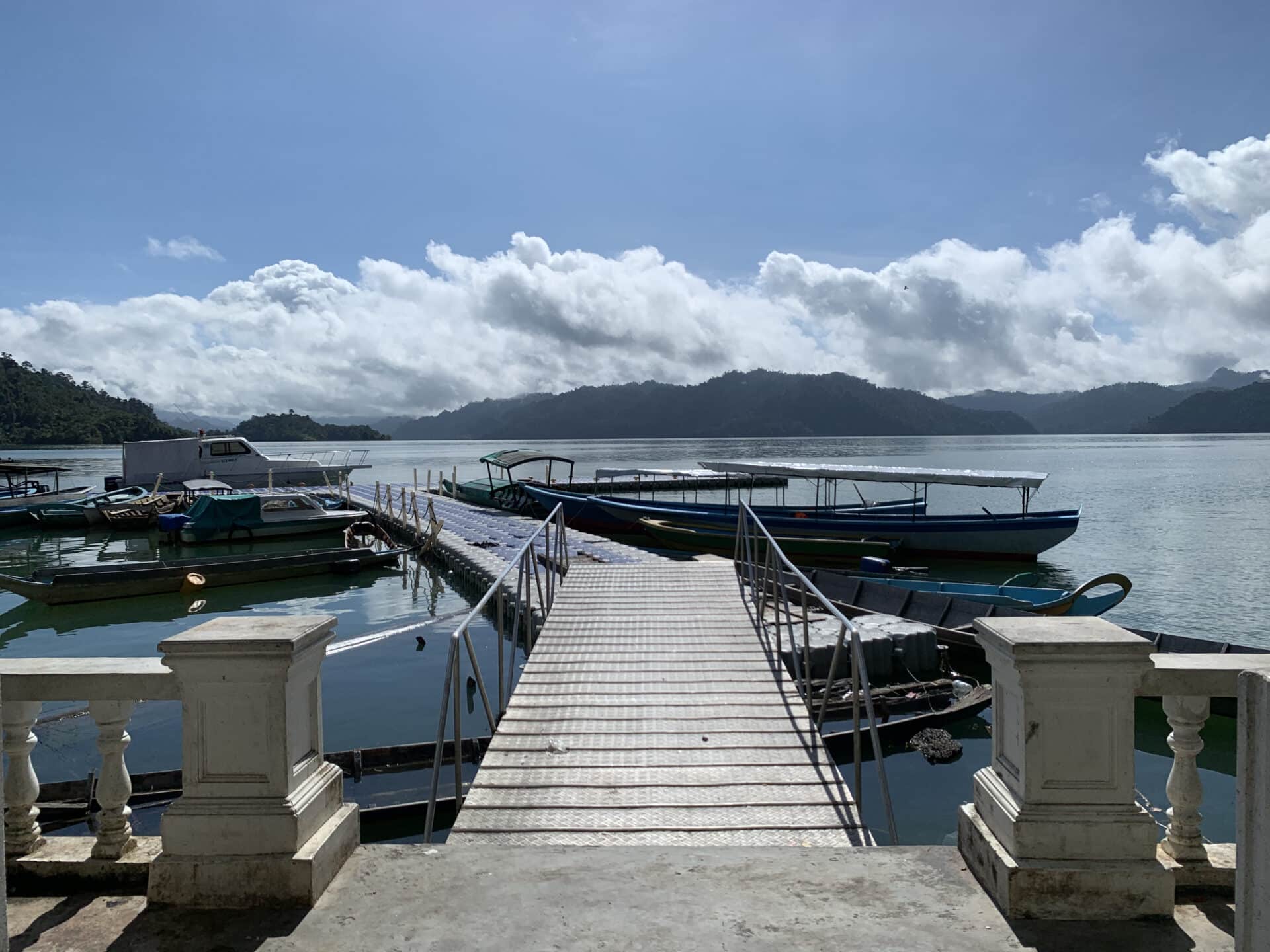
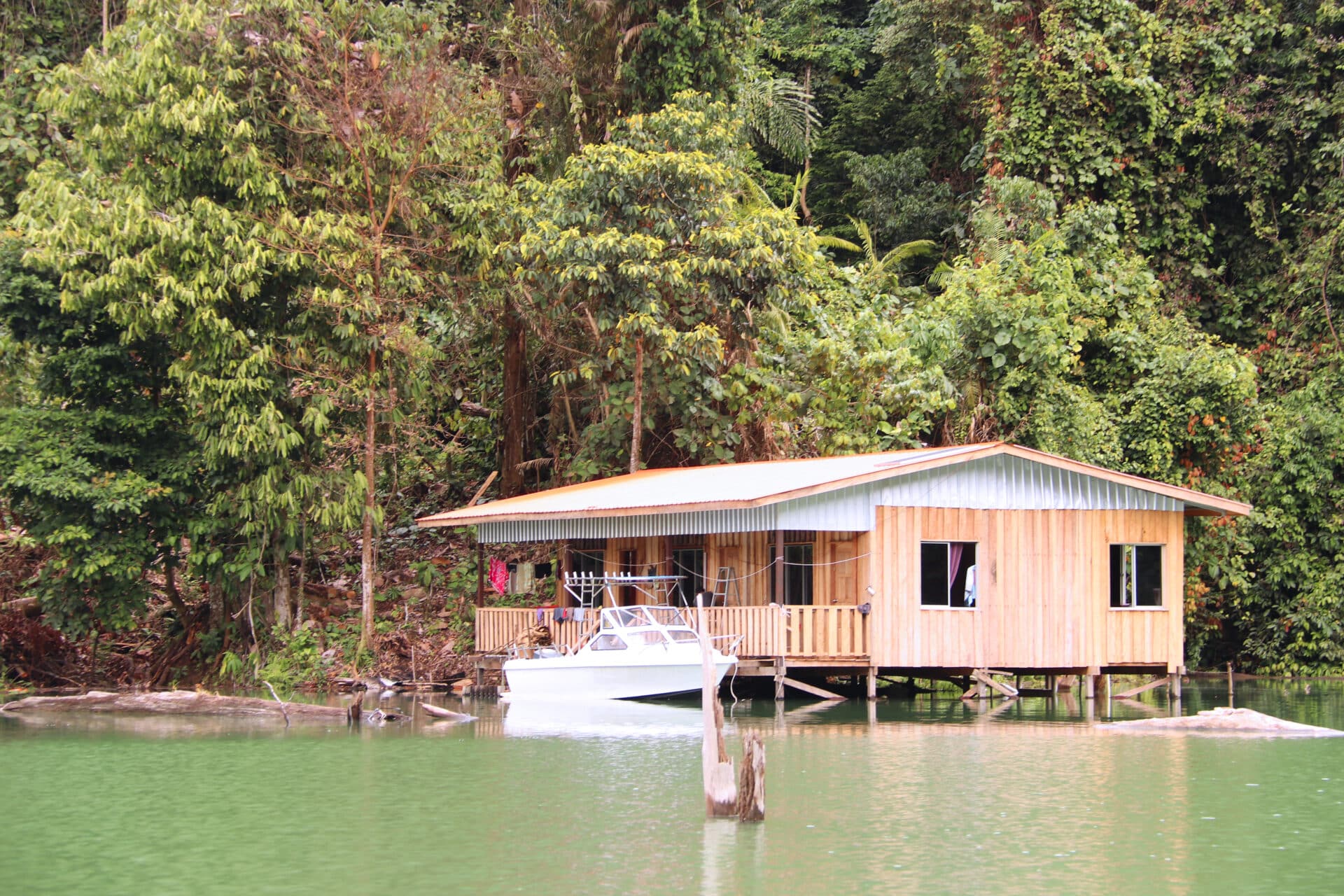
The water is fresh and cool here, cooler than the water in the dam reservoir, because it comes straight from a mountain stream. I forget to ask what the mountain’s name is, or the stream’s, for that matter. Kayan people have names for every single stream and tributary, and they remember them all. I forget to ask. I forget that my father won’t offer up information unless explicitly asked. I don’t know how much I don’t know, so I don’t know where to start. It’s so frustrating trying to retrace my family tree with clumsy fingers dirty from digging. My people’s history is all right there but I can’t access it; there’s a language barrier and hundreds of meters of water in between us. And sometimes, I simply forget to ask.
After the waterfalls, we head back to the lodge. My father and uncle catch some fish and it’s time to eat again. My father named it the Bayoh Lodge after the trees that grow in abundance there. According to my grandmother, Bayoh leaves are medicinal. If you boil the leaves and wrap them around your abdomen, it cures stomach pain.
How appropriate, I think, sipping my coffee while I stretch out on the verandah, gazing at the lush scenery all around me, how appropriate for our lodge to be named after a thing that takes away pain.
*
In 1998, the government relocated my longhouse—along with many others—to Sungai Asap because they wanted that land for the Bakun Dam. I was seven years old at the time, and my memory of the event is hazy at best. They say the relocation was voluntary but we all know what “voluntary” means in this country. The Bakun Dam is 205 meters tall and has a surface area of 695 square kilometres. For contrast, Singapore is 728 square kilometers. Yes, all of Singapore.
Last year, I discovered a two-hour-long, twenty-year-old video of my old longhouse. It was like looking at a ghost, like seeing a place from a dream you had a long time ago. It was posted on my cousin’s Facebook page and, as it turns out, was filmed by my father. I was shocked, but at the same time, not shocked at all. He never offers up information unless explicitly asked, and I don’t know if that’s a cultural thing, or a generational thing. Perhaps, as is often the case, it’s a little bit of both. My father was documenting the days leading up to our exodus. He was walking up and down my old longhouse’s wooden verandah, recording the old doors, the old walls, the old land, the old river, the old trees, because that would be the last time any of us would ever see them.
In one scene, a pui ake’ (grandfather) was performing a ritual. He was saying goodbye to the land. The video was pixelated and the audio was muffled, but I heard him saying, “We are leaving this place…” and someone from off-screen interjected, yelling: “We’re not leaving, we are running away! We are running away.”
It must have been one of my uncles, but I couldn’t recognize his voice, twisted by pain and anger and defeat. The same pain and anger and defeat that has haunted me since I was old enough to understand how things are done in Malaysia.
Decades later, my father, along with quite a few of my relatives, returned to Bakun and built floating houses, homestays, and lodges. I guess we got tired of running away.
*
The surface of the Bakun Dam is a dead zone. How’s that for a metaphor. No telephone signal, and definitely no internet. The only electricity we have is intermittent at best—my uncle jerry-rigs some solar panels and a couple of car batteries together into a rudimentary charging station for our electronics. Kayan people are nothing if not resourceful. “We make do” should be our community motto.
The day passes slowly in Bakun. There’s not much to do here for a city girl. My father encourages me to swim in the dam water because “the sulphur is good for you,” he says. That’s cool, I guess. But I never fully relax in the cloudy water, morbidly fascinated by the creepiness of it all. I can’t help but think of all the things that drowned here: calcified trees, animal bones, and empty longhouses, hundreds of meters beneath my floating body. Sometimes bubbles rise up in random places, breaking the eggshell-blue surface of the water. Perhaps it’s the ghosts of deer and ants and civet cats from two decades ago saying hi.
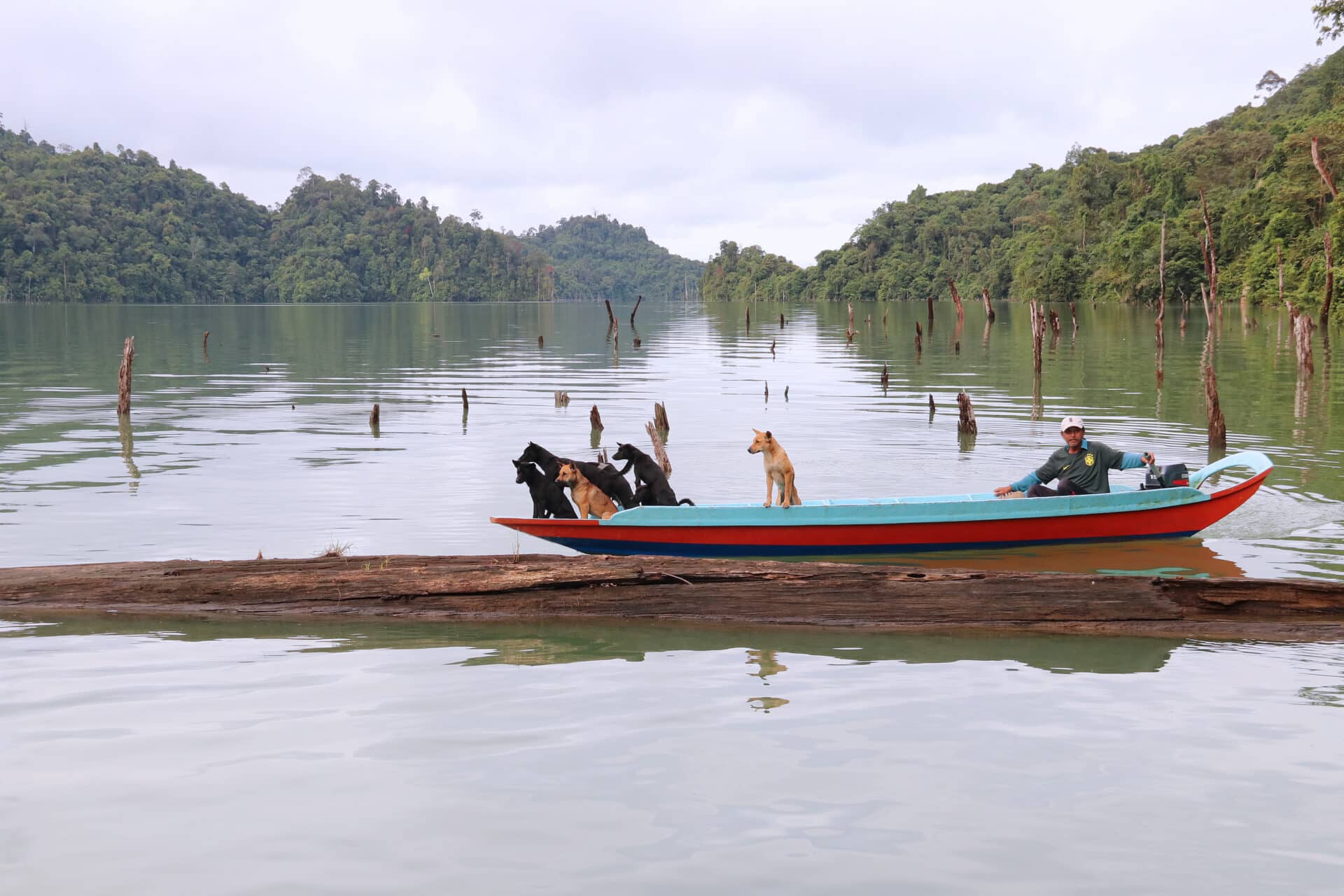
As I float, I ruminate. What is the cost of assimilation. What is the cost of progress. Was it worth it? On the one hand, our new longhouse has electricity, running water, an actual asphalt road leading up to it. Luxury! On the other hand, it’s basically empty except for Christmas time. So many of us moved to bigger cities for education, jobs, survival. There’s nothing here for us anymore. We used to be able to live off the land. Now we have land to farm pepper and such, but it’s not profitable enough to sustain all of us. Not enough wild game to hunt, not enough fish in the river that’s so muddy and choppy we don’t even swim in it. After spending a weekend at the Bayoh Lodge, the “new” longhouse feels so… cultivated. You need to drive or walk a ways to meet the jungle: it doesn’t greet you when you open the door anymore. We have been downsized. We have been tamed.
But progress marches on, right? Or maybe not. Idle hands and idle minds are a bad combination for the young folks looking for some mischief to get up to. Substance abuse remains a big problem in rural areas. And the dam doesn’t seem to generate much of anything; Sarawak is still one of the most underdeveloped wilayah in the country. The biggest hydroelectric dam in Malaysia is a mere forty-five minutes away from my longhouse, but I don’t feel empowered at all.
Assimilation is sacrifice. Assimilation is costly. You pay for your bachelor degree with 200 meters of water flooding your father’s longhouse. You pay for your fluency in bahasa perantaraan with burnt bridges, and now you need an interpreter to talk to your grandmother. But what do you call a sacrifice made unwillingly? Is that not murder? What do you call it when you take (and take and take and take) more than what was agreed upon? Is that not theft?
Did you know that some longhouse stilts were made from belian wood? Hard as rock, sturdy as steel. I don’t know if that was the case for my old longhouse. I was so young when we moved to Sungai Asap, and sometimes I forget to ask these things. But I can’t help but picture it: my father’s house under fathoms of water, dark, dead, and empty on its ironwood legs.
Was drowning my ancestral home worth it? Was it worth uprooting us and short-changing us on what we were promised? Was it worth an entire generation of Kayan youths having to cosplay as archaeologists just to keep our heritage alive? The answer depends on who you ask, I guess. But Kayan people are nothing if not resilient. “We’re still here” should be our community motto. Despite being uprooted, colonized, converted, and Bangsa Malaysia-nized, we are still here.
One question I did remember to ask my father was if he felt worried that the government would punish him for building on the dam – what if they wanted to reclaim the land his lodge sat on, just like they did with our old longhouse. He scoffed and said, no pain or defeat in his voice, but perhaps a little bit of anger: “They can try!”
They can try. But we’ll still be here. Existence is resistance, and we are still here.
© Bethany Luhong Balan
Commissioning editor: Anna Tan
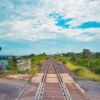


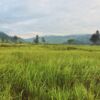
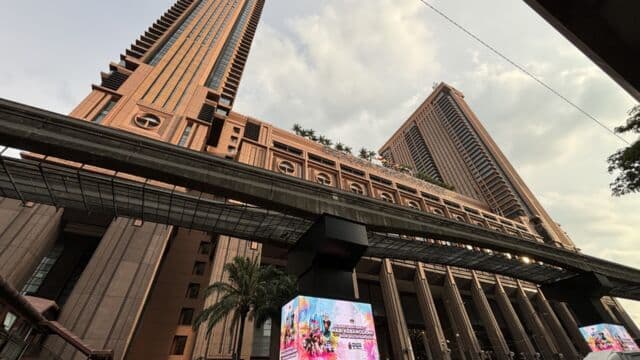
-640x360.jpg)
